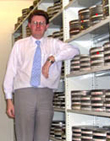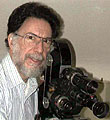|
|
 
|
|
Author
|
Topic: Found some vintage film
|
Randy Stankey
Film God

Posts: 6539
From: Erie, Pennsylvania
Registered: Jun 99
|
 posted 07-01-2002 11:23 PM
posted 07-01-2002 11:23 PM




My FiancÚ is in charge of the local historical museum. Today she visited the home of a prominent Erie family to do some historical research. During her conversations she found out that there is a quantity of old film "in storage" at the house. The family has been an important part of Erie history for over 100 years. They are wealthy enough to have almost anything on their hands. They could have bought, made or had made just about anything.I asked my FiancÚ if they knew whether it was 8mm, 16mm or 35mm. Of course, being a "lay" person she had no idea, nor did they. Knowing how wealthy they are it could be anything. I was able to find out that the film dates as far back as far as the 1930's and 1940's. Some of it is motion picture film. Some of it is still pictures. I'm thinking about 3 things: 1) Historical significance.
2) Preservation/restoration.
3) If there is any nitrate in the collection. Number 1:
Pretty self explanatory. Somebody needs to go through the stuff and see what's on it. The museum has an archivist who knows her stuf pretty well. Between her and me, we could put on the white gloves and face masks, go into a clean room and carefully examine the stuff and catalog it. Number 2:
Should we find that the film is deteriorating it should be a simple matter to just pack the film up the way we found it and call for professional help. Where is a good place to look for this kind of expertise? I assume that, should we find that the stuff is falling apart the best course of action is to try to have it duplicated on to modern film and then put the originals into "cold storage". (or whatever). Number 3:
This is the one that's got me a bit freaked...
I know that 16mm and 8mm formats were designed to NOT be nitrate. But, about what year were these formats available? I find it hard to imagine that there is anything but 8mm or mabe some 16mm... but you never know. If I find that I have some 30's vintage 35mm on my hands I could very well walk into an attic full of nitrate.  No doubt, I (or somebody else) is going to have to take a look at this stuff. So... what are the parameters here??
| IP: Logged
|
|
|
|
Leo Enticknap
Film God

Posts: 7474
From: Loma Linda, CA
Registered: Jul 2000
|
 posted 07-02-2002 02:28 AM
posted 07-02-2002 02:28 AM





Historical SignificanceIf the film is 35mm, it is very unlikely (though not impossible) for it to be amateur film. If it is a professionally produced film, this immediately raises the question of whether it is preserved elsewhere and if so, whether the elements your fiancÚ has found are in better condition than the master elements already archived. The first thing I suggest is that you attempt to date the film stock, and then make as many notes as you can as to its content. If you cannot remove the film from this family's home as yet, this might be difficult as you won't be able to do any sort of bench examination, but information written on the containers or spacing/leaders on the front of the reels could well help (could you take photos of these?). If the film is 35mm and possibly if it's 16mm, there will be a code marking between the perforations and the edge of the stock (laterally between the perfs in the case of 16mm) which will identify the date of manufacture. A table of these codes and the years they refer to can be downloaded from Jeff Joseph's website at www.sabucat.com . This should certainly give you some information which will aid an archivist in assessing the significance of the collection. Preservation/Restoration How to do this is a very complex decision based on a huge number of factors, e.g. the historical significance of the material, its existing preservation status (see above) and the film base, generation and physical condition of the elements you're dealing with. For example, if these are unstable camera originals of footage which an archivist decides are of significant interest, (s)he would probably decide to dupe them straight away, which is the most expensive option. If, however, they are release prints of a film which has already been preserved but from an imperfect source (e.g. a f/g pos with serious scratching) and which show no immediate sign of decomposition, they might simply be stored in an appropriate temperature and humidity-controlled vault pending a major restoration exercise that involve assessing many tens, or even hundreds, of similar elements found elsewhere. My gut feeling would be that your fiancÚ should approach a film archive rather than attempt the preservation process herself, unless she has good lab contacts and a lot of money to spend. If the footage is of local interest, she would probably be able to work out a deal whereby the archive looks after the master elements (if they are so designated) but that she can buy a print at cost price. The expertise would come free. Is it nitrate? If the stock is 35mm and manufactured before 1948, then it probably is. 35mm safety stock was used for some applications pre-1948, first in the form of cellulose diacetate, and from 1937 acetate propionate. Both were a lot more expensive than nitrate and a lot less physically durable, and so they were only used in situations when appropriate fire safety precautions could not be taken, e.g. newsreel filming in dangerous environments or when it was necessary to send release prints through the ordinary mail (adverts, trailers and so on). Although the International Federation of Film Archives do not recommend this, I would suggest that the easiest way to find out for sure if this is nitrate is the burning test. I say this because it is the only known nitrate identification test which is 99.9% accurate and does not involve dangerous chemicals. The 0.1% are nitrate elements which have been treated with a fire-retardant coating, but these are very rare. Take a small section of spacing from the end of a reel (say, 2-3 frames), and in an open, well-ventilated space put a match to it. If it is acetate it will behave very much like paper, i.e. it will burn slowly and steadily. If it's nitrate you will probably find that it takes 1-2 seconds to ignite, but then there will be a huge flame and it'll be gone. You'll also smell some acrid, sulphurous smoke. If the stock is anything other than 35mm, then (unless your Erie family collected 16mm films from the Eastern Bloc during the 50s and 60s), it is not nitrate. If you do have nitrate on your hands, there are some common-sense rules to follow. Store it in flame-retardant containers if possible, and try not to store more than 2,000 feet in any one location. If you have a garage, shed or outhouse separate from your main house I'd be inclined to put it there until you can transport it to a recognised film archive. If you have to store it on museum premises, tell the local fire department that it's there (and make sure you aren't breaking any laws by storing it there). The fumes given off by burning nitrate are highly toxic and life-threatening in significant quantities and in an enclosed space. Therefore the local fire authorities need to know, should they be required to attend a fire in a building in which nitrate is being stored, so that they can take the appropriate precautions. If you ship the stuff using a commercial carrier, make it very clear that the consignment contains cellulose nitrate (flammable) film, that they must only ship it in a refrigerated truck, and make them sign something acknowledging what it is and accepting responsibility for it. In the UK, there is one commercial carrier (TNT) that does most nitrate shipping for film archives, and they are used to dealing with it. There may well be a similar arrangement in the US, I don't know. If you perform a bench examination on any nitrate, make sure that the winding bench is properly earthed - a static spark could ignite it. For possible film archive contacts, see the website of the Association of Moving Image Archivists - www.amianet.org - which should have a list of member institutions. Alternatively, you could post details of the collection on the AMIA e-mail list (you'll need to subscribe, which can be done through the website). Finally, your fiancÚ may be interested in some reference stuff on dealing with vintage film for her museum bookshelf: Paolo Cherchi Usai, Silent Cinema - an Introduction - London, BFI, 2000 (2nd ed.), ISBN 0851707459. Henry Wilhelm & Carol Brower, The Permanence and Care of Color Photographs: Traditional and Digital Color Prints, Color Negatives, Slides and Motion Pictures, Preservation Pub. Co. (1993), ISBN 0911515003. Mark Read & Mark-Paul Mayer, Restoration of Motion Picture Film, Butterworth-Heinemann (2000), ISBN 075062793x. All of these provide useful reference material when examining any film collection which might land on your doorstep, especially for small museum and archive collections which are not used to dealing with film on a day-to-day basis. At $115, Read & Mayer is not cheap, but it's well-written, thorough, and the only book on the market which deals with this subject so systematically, therefore I'd say it's worth it. Dates: 35mm - 1889. 16mm (double-perf) went on the market in 1923, single-perf 16mm with optical sound dates from the mid-30s. 8mm not sure but early 30s I think. We have standard 8 elements going back to 1937. 9.5mm - 1919. Super 8 - 1963. 70mm dates back to the late 20s in experimental form (e.g. Fox Grandeur); I don't know whether these prototypes were nitrate or diacetate. Given the mechanical tolerances involved, I suspect nitrate.
| IP: Logged
|
|
|
|
|
|
|
|
Randy Stankey
Film God

Posts: 6539
From: Erie, Pennsylvania
Registered: Jun 99
|
 posted 07-02-2002 09:56 AM
posted 07-02-2002 09:56 AM




Just hearing information like this second hand is not a good way to get information but until I or some other knowledgeable person can get in there and look at it there's no way of telling.I didn't know that 16mm was available as far back as the 20's. That does ease my mind a bit. I only thought it was available since the 50's. Just goes to show how much I know!  What about 8mm? What about 8mm? I knew that 16 & 8mm formats were designed as semi-professional or consumer formats and were made on safety stock right from the beginning. (Except for very rare instances.) If I understand correctly, 16mm was chosen as a format specifically so that somebody couldn't slit a piece of 35mm in half and use it... thereby precluding the possibility of nitrate film getting into the hands of an inexperienced person. I, personally, don't have a problem if I run into nitrate. I have enough experience with flammable/explosive objects to be able to hold my own. I also know when NOT to fool around. I've seen some people get seriously F*UCKED from fooling around where they shouldn't be.
(I personally know I guy who lost both hands in a "dynamite fishing" incident.... REALLY!) I don't think there is a big chance of there being any nitrate in there. IF there is, I don't think there will be much of it. However, when it comes to nitrate there's no such thing as being too careful. My main concern would be getting the stuff out of their house. I'd feel like sh*t if I found out that their house burned down due to spontaneous combustion and there was something I could have done to prevent it. The museum's archives are housed in a 50's-era bomb shelter. There's not a problem with fire but for the other items in the archives. Honestly, my thoughts would be to find out whether the film is any good and go from there. If it's not of any particular importance, seriously, I'd think about having it incinerated. (Our town has a Haz-Mat surrender program, whereby people can bring stuff they find in their basement to the local fire departments for safe disposal.)
If it IS any good I'd find an archive to take it off our hands. If I can get them to show me this film my plan is to look at it, segregate any nitrate film then open up a can or two and give it a sniff for vinegar. Anything that doesn't look too bad we'll take into a clean room and give it a look-see. If it's smelly or falling apart we'll decide if we want to have it preserved. Otherwise we'll decide if it is to be kept for "heirloom value only" or taken out for disposal. My bet is that unless it's deteriorated beyond use they'll just want to save it and maybe get a few of the most "importat" things copied.
| IP: Logged
|
|
|
|
|
|
John Pytlak
Film God

Posts: 9987
From: Rochester, NY 14650-1922
Registered: Jan 2000
|
 posted 07-02-2002 11:10 AM
posted 07-02-2002 11:10 AM





The link I cited indicates 1936 as the date for 8 mm KODACHROME film.Remember, 8 mm home movies are 16 mm film perforated for the 8 mm format, exposed in two passes through the camera, then slit to 8 mm after processing:
http://www.jfk-info.com/zreport.htm ------------------
John P. Pytlak, Senior Technical Specialist
Worldwide Technical Services, Entertainment Imaging
Research Labs, Building 69, Room 7525A
Rochester, New York, 14650-1922 USA
Tel: +1 585 477 5325 Cell: +1 585 781 4036 Fax: +1 585 722 7243
e-mail: john.pytlak@kodak.com
Web site: http://www.kodak.com/go/motion
| IP: Logged
|
|
|
|
|
|
Gerard S. Cohen
Jedi Master Film Handler

Posts: 975
From: Forest Hills, NY, USA
Registered: Sep 2001
|
 posted 07-09-2002 05:50 PM
posted 07-09-2002 05:50 PM




Randy: You've got me on tenterhooks wondering what treasures you might
unearth in this film archaeology exploit. Won't you please keep us informed of what turns up? At a tag sale in an old tudor house in my neighborhood, where the
premises were being emptied, I found a decaying wooden box full of reels of b/w 16mm home movie reels going back to the 1930's at least.
Whoever had lived there had left it behind, but the professional tag-sale ladies refused to sell me the footage. They tried to get me to buy the decaying wooden carton instead! Alan Kattelle, film historian,author of HOME MOVIES and founder
of the recent Movie Machine Society, is curating an assemblage of historical home movie footage for a New England historical society
undertaking. Seems home movies are a timeless legacy of the way we lived then, and the way we live now. They form a counterpart to our fantasy self-images of the commercial and artistic cinema. Gerard
| IP: Logged
|
|
Randy Stankey
Film God

Posts: 6539
From: Erie, Pennsylvania
Registered: Jun 99
|
 posted 07-09-2002 09:22 PM
posted 07-09-2002 09:22 PM




The whole reason the museum is talking to the family is because they are working on a "Lifestyles of the Past" type of exhibit.The museum is housed in a 1890's era victorian mansion. The family that Melanie, my fiancÚ, is talking to used to own the mansion before it was deeded to the city. They are going through the old family albums and stuff like that to find out more of the daily life elements of living at the turn of the century. Melanie is thinking pretty much the same thing you are, Gerard. She's going through the photos and having them duplicated for the diaplays. I gave Melanie all the information from the links about nitrate and film dating, etc. I told her that even if there wasn't nitrate film in the family archives that somebody needs to go through that film and have a look at it and make sure that it's not deteriorating, lest it starts to spoil. Next time Melanie has a chance to talk to the family she's going to ask them more about the film they have and tell them what we found out. We'll go from there and report back what we find. 
| IP: Logged
|
|
|
|
All times are Central (GMT -6:00)
|
|
Powered by Infopop Corporation
UBB.classicTM
6.3.1.2
The Film-Tech Forums are designed for various members related to the cinema industry to express their opinions, viewpoints and testimonials on various products, services and events based upon speculation, personal knowledge and factual information through use, therefore all views represented here allow no liability upon the publishers of this web site and the owners of said views assume no liability for any ill will resulting from these postings. The posts made here are for educational as well as entertainment purposes and as such anyone viewing this portion of the website must accept these views as statements of the author of that opinion
and agrees to release the authors from any and all liability.
|

 Home
Home
 Products
Products
 Store
Store
 Forum
Forum
 Warehouse
Warehouse
 Contact Us
Contact Us




 Printer-friendly view of this topic
Printer-friendly view of this topic











 What about 8mm?
What about 8mm?




